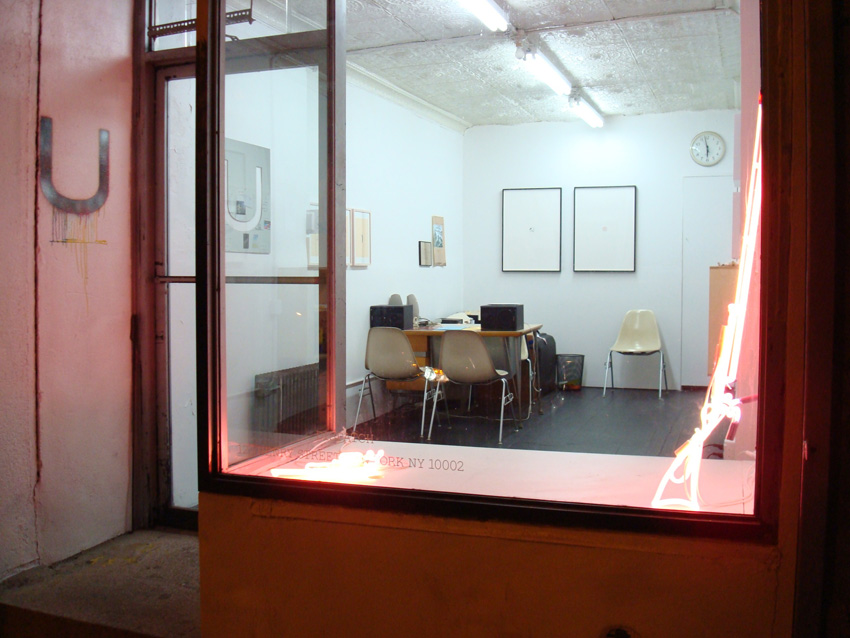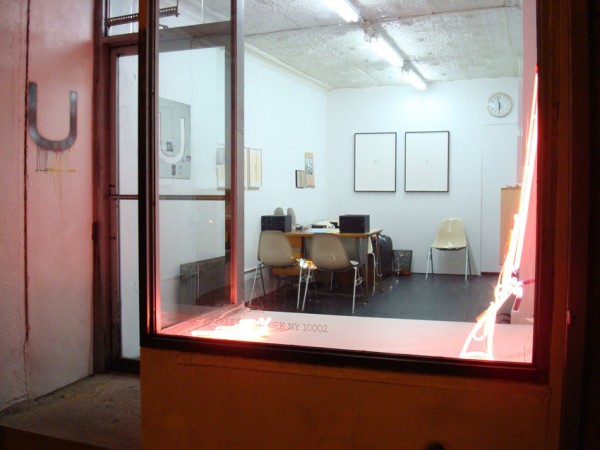Dispatch

Please scroll down for english version
Dispatch, duo de curateurs new-yorkais officiant sous ce nom depuis 2007, dynamite les conventions du traditionnel non-profit space pour poser les bases d’un curateur-manager à la manière des tourneurs de groupes de rock. Ni galerie à proprement parler, ni artist-run space, ils sont animés par une foi en l’énergie du curateur qui les mène à réaliser leurs projets du Pôle Nord au Japon en passant par l’Europe. On les a vus récemment à la dernière foire Artissima de Turin, à la NY Art Book Fair, et ils seront prochainement à Liste, la jeune foire bâloise, pour présenter les travaux d’Erica Baum, José León Cerrillo, Tom Holmes, Justin Matherly et Vicente Razo.
Aude Launay: Vous vous présentez comme un bureau de création curatoriale, mettant en avant votre flexibilité et votre réactivité, vous positionnant surtout contre un certain establishment curatorial préoccupé, je vous cite «par l’administration institutionnelle et les bureaucraties officielles» (1). Y-a-t-il un événement particulier qui vous a amené à vous définir ainsi, ou est-ce avant tout un positionnement politique ?
DISPATCH: L’idée de faire de Dispatch un site de productions multiples et un lieu critique est venue de nos expériences personnelles de travail au sein d’institutions. Étant donné les diverses expériences et compétences que nous avions tous deux assimilé en tant que curateurs et producteurs au Whitney Museum (pour Howie Chen) et au Swiss Institute de New York (pour Gabrielle Giattino), nous avons créé Dispatch selon l’hypothèse qu’une structure plus concise et plus petite pourrait être plus autonome et ainsi plus efficace. Nous essayons de répondre à un champ curatorial institutionnel qui est devenu d’une certaine manière trop officiel et bureaucratique à New York- ce qui inclut les grands musées comme les petites structures associatives qui étaient avant cela plus vives dans leur programmation. Le modèle que nous essayons de mettre en œuvre repose sur la rigueur et la flexibilité.
Et cela fonctionne-t-il? En effet, comme votre nom l’indique, vous êtes tout particulièrement intéressés par l’idée de monter des expositions hors de votre base, vous en organisez beaucoup à l’étranger, en Europe et ailleurs… Vous êtes donc, d’une certaine manière, de purs curateurs, puisque votre principal intérêt réside dans l’exposition, mais d’un autre côté, vous devez aussi gérer tous les aspects techniques et surtout financiers; est-ce facile ?
Oui, nous souhaitons maximiser l’activité curatoriale de Dispatch, ou du moins développer ce qui nous intéresse le plus: travailler en étroite collaboration avec les artistes, engager un dialogue critique avec les autres, et mener à bien nos projets avec l’urgence qu’ils nécessitent. Comme toutes les associations et les entreprises, nous sommes bien évidemment soucieux et contraints par les facteurs matériels et financiers, tout particulièrement dans le climat économique actuel. Notre effort s’exerce vers un équilibre entre une pratique curatoriale active et des solutions de financement durables pour que nous puissions pursuivre le projet Dispatch. Nous essayons de faire éclore de nouvelles manières de nous auto-financer, comme avec notre Portfolio Project (2) que nous produisons avec des artistes avec lesquels nous avons déjà travaillé et qui nous soutiennent.
Nicolas Bourriaud, un célèbre curateur français, illustre la différence entre les curateurs et les conservateurs ou autres académiciens, en la comparant à celle qui peut exister «entre les plongeurs et les océanographes» (3). Comment vous considérez-vous, pour parler plus spécifiquement de votre manière d’envisager le curating ?
Laissons la plongée aux artistes, en fait. La fonction et le rôle du curateur n’est pas simplement d’explorer ou d’établir de nouveaux territoires; en ce qui nous concerne, il est moins question de découverte que de pertinence. En tant que curateurs, nous remplissons plusieurs rôles qui contribuent tous à la production et au soutien nécessaires à l’exposition du travail des artistes. À Dispatch, le rôle du curateur implique d’être écrivain, assistant de production, porte-parole, comptable, conservateur, et nous avons fusionné les hiérarchies et la différenciation entre ces rôles pour qu’il y ait le moins possible d’administration qui pourrait encombrer nos communications internes, amis aussi avec les artistes et notre public. La question serait donc peut-être plutôt: ne serait-il pas possible que quelqu’un soit à la fois plongeur et océanographe ?
À ce propos, parlons des artistes avec lesquels vous travaillez. On retrouve des liens entre certains des artistes que vous avez récemment exposés, tels que Daniel Lefcourt, Erica Baum, Tris Vonna-Michell et de manière un peu plus lointaine, José Léon Cerillo, qui s’intéressent tous à la question du langage… Avez-vous défini une ligne qui synthétiserait votre pensée curatoriale ?
Il n’y pas de ligne catégorique qui décrirait les pratiques des nombreux artistes avec lesquels nous collaborons. Effectivement, certains d’entre eux s’intéressent particulièrement au language et à ses structures, mais aussi à la signification de la forme et des matériaux… à la géométrie et à ses conceptions historiques, tout autant qu’à une recherche sur l’histoire et le récit, et à l’inscription de la politique dans le travail des artistes. Il n’ y a pas de formule; c’est une ligne continue d’analyse, à la fois de l’œuvre contemporaine et des contextes et des histoires qui l’imprègnent. Chaque exposition peut aussi être vue comme une réponse à la précédente ou à la série de projets qui la précédait dans notre programme. Bien que les choses diffèrent, d’un point de vue esthétique, entre chaque exposition/artiste, se dessinent une recherche et un fil d’investigation soigneusement réfléchis que nous essayons de développer.
1 : in New York Magazine, 8 décembre 2008
2 : Edition annuelle et limitée d’un portfolio de multiples de plusieurs artistes, par exemple John Trembley, Philippe Decrauzat, Mika Tajima, Daniel Lefcourt ou Eileen Quinlan…
3 : « Tate Triennial 2009 », Entretien avec Nicolas Bourriaud par Tom Morton, Frieze n°120, jan-fév. 2009.
New York curator duo Dispatch has been exploding the conventions of the traditional non-profit art space since 2007, laying the foundations for a new breed of curator: that of the curator-manager, in the vein of the rock n’ roll booking agent. With neither a gallery to speak of, nor an artist-run space, they are animated by a faith in pure energy, one that has led them everywhere from the North Pole to Japan and Europe. They recently appeared at last year’s Artissima fair in Turin and at the NY Art Book Fair and they will travel to Liste, the new art fair in Basel, to present works by Erica Baum, José León Cerillo, Tom Holmes, Justin Matherly, and Vicente Razo.
You introduce yourselves as a curatorial creation bureau, bringing out your flexible and reactive nature, getting into position against the curatorial Establishment, preoccupied, and I quote you, « with institutional self-administration and formalized bureaucraties ».1 Did some special event led you to think it that way, or was it first a political position?
DISPATCH: The idea for Dispatch to exist as a multiple production site and critical locus did come out of both our experiences working within institutions. Given the diverse skills and experience that we both gathered as curators and contemporary art producers at the Whitney Museum of American Art (Howie Chen) and Swiss Institute, NY (Gabrielle Giattino), we created Dispatch from the hypothesis that a smaller, more concise structure would lead to more autonomy and efficiency. We are trying to respond to a field of institutional curating that has become in a way overly-formalized and bureaucratic in New York City—this includes large-scale museums and small non-profits that used to be more agile in their programming. The model we are trying to intimate hinges on flexibility and rigor.
And does it come true? I mean, as your name describes it well, you specially try to make up shows outside of your Dispatch-base, you make shows abroad, in Europe, etc. So, you both are, in a way, pure curators, as your main concern is the making of shows, but in some other way, you have everything technical or financial to mind; do you come through easily in these days?
Yes, we try to maximize curatorial activity at Dispatch or at least amplify that which we find most interesting: to work closely with artists, engage in critical dialogue with others, and realize projects in an urgent manner. Like all organizations and businesses, we are of course concerned and constrained by financial and physical factors especially in this current economic climate. Much of it is balancing a active curatorial practice and sustainable funding solutions so that we can continue with Dispatch as a project. We try to come up with new ways such as our ongoing editioned Portfolio Projects2 that we produce with artists we have worked with and support our space.
Nicolas Bourriaud, a famous French curator, illustrates the difference between curators and academics saying that it’s the same « difference between deep-sea divers and oceanographers »;3 how do you consider yourselves, to look more precisely as the way you think the curtaorship?
Let’s leave it to the artists to do the deep sea diving, actually. The role and the function of the curator is not just to « explore » or chart of new territory as far as I’m concerned, it’s less about discovery and more about application. As curators we fill many roles which all contribute to the production and support for the exhibition of artists’ work. At Dispatch the curators’ roles include writer, production assistant, spokesperson, bookkeeper, preparator, and we have collapsed the hierarchies and differentiation between these roles so that there is minimal administration which may congest our communication with each other, the artists with whom we work, and our audience.Perhaps the question should be: Would it be not possible for one to be both a deep-sea diver and an oceanographer?
In this connection, let’s talk about the artists you work with. We can detect a link between some of the artists you showed recently, such as Daniel Lefcourt, Erica Baum, Tris Vonna-Michell and a little further José Léon Cerillo, who are all interested in the language issues… But is there a thoughtful line that could define your aims in your curatorial activities?
There is no categorical line to describe the practices of the many artists we work with. Yes, some of the artists are interested in language and its structures, but also the significance of form and material…of geometry and the historical approaches to it, as well as inquiry into history and narrative and the inscription of politics in artist practices. There is no formula; it is a constant line of analysis, of both contemporary work and the contexts and histories that inform it. Each show can also be seen as a response to the previous exhibition or series of projects that preceded it in our program. Though aesthetically things may differ with each exhibition/artist, there is a considered inquiry and investigatory thread we are trying to develop.
1 in New York Magazine, 8 décembre 2008
2 Yearly limited edition of a portfolio of various artists, such as John Trembley, Philippe Decrauzat, Mika Tajima, Daniel Lefcourt ou Eileen Quinlan…
3 « Tate Triennial 2009 », interview with Nicolas Bourriaud by Tom Morton, Frieze, issue 120, jan-feb 2009.
- Partage : ,
- Du même auteur : Paolo Cirio, RYBN, Sylvain Darrifourcq, Computer Grrrls, Franz Wanner,
articles liés
Céline Poulin
par Clémence Agnez
Calla Henkel & Max Pitegoff
par Ingrid Luquet-Gad
Dena Yago
par Ingrid Luquet-Gad
